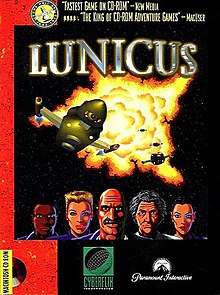Lunicus
Lunicus is a 1993 computer game developed by Cyberflix and published by Paramount Interactive.[2] It shares many traits in both graphical style and gameplay with some of Cyberflix's other games, like Jump Raven. It was rated as 1993 CD-ROM game of the year in the magazine MacWorld.[3]
| Lunicus | |
|---|---|
 | |
| Developer(s) | Cyberflix |
| Publisher(s) | Paramount Interactive |
| Programmer(s) | Bill Appleton |
| Artist(s) | Jamie Wicks Susan Metros |
| Writer(s) | Ben Calica |
| Composer(s) | Scott Scheinbaum |
| Platform(s) | Windows 3.1, Mac OS |
| Release | |
| Genre(s) | Adventure game |
It was released for the Mac and Windows 3.1, and was one of many adventure games released to capitalize on the adoption of CD-ROM drives.
Gameplay
Lunicus is primarily an adventure game; in between combat missions you may wander the moon base you are stationed on and talk to the various NPCs contained within, with full voice acting and some stilted animation which is characterized on the game packaging as "Talking Cyber Puppets".
During the combat missions, the player enters various parts of Earth and cleans out alien infestations either on foot or in a vehicle. The player's weapons are relatively static throughout the game, including machine guns, rocket launchers, and grenade attacks. While in the vehicle, the player can opt to duck inside one of the buildings to find additional ammunition and supplies. Nearly all buildings (except for quest-specific ones) are identical.
The game's latter missions involve defending the moon base itself from attack by the alien forces, and then attacking the alien mothership.
The player's activities are seen from a first person perspective, but they can only face one of four directions, turning left or right on a tile-based grid similar to games such as Scarab of Ra. Direct targeting is accomplished with the mouse, while movement is accomplished with either the mouse or the game's heads up display.
The game included several pre-rendered full motion video sequences, usually bookending the combat sequences. Several difficulty levels are available, which alter the strength and numbers of the enemy waves.
Nearly all graphics in the game are pre-rendered sprites, including walls and city components.
Plot
As the game begins, the player is stationed on the United Nations moon base, Lunicus, to defend against the threat of the alien attack, led by the Hive Queen.
The aliens are present as an archeological dig in 2023 unearths several alien artifacts, one of which is mistakenly activated and alerts the alien force.
Development
Lunicus was the first game developed by CyberFlix, which was not officially incorporated until after the project's release.[1] It was created with DreamFactory, a development environment programmed by CyberFlix founder William Appleton, who had previously designed the Macintosh software SuperCard.[3]
Lunicus was released in April 1993.[1]
Reception
In its initial Macintosh release, Lunicus was a commercial success, with sales of 50,000 units by August 1994. Around August 28, another 50,000 units of the game were shipped for Microsoft Windows. CyberFlix's Erik Quist expected the game to sell 100,000 units overall "by Christmas", Barbara Kantrowitz of Newsweek reported at the time.[3] By January 3, sales of Lunicus had reached close to the 100,000 mark.[4]
Macworld presented Lunicus with its 1993 "Best CD-ROM Game" award. The magazine's Steven Levy called the game "a mindblower", and praised its visuals and fast-paced action. Singling out the game's high frame rate as its best feature, he wrote, "Unlike other CD-ROM games, which have an annoying lag between the time you pull the trigger and the time something happens, Lunicus moves with sufficient speed to keep you in the action."[5]
Computer Gaming World in August 1993 criticized the varying quality of the graphics but concluded that Lunicus was "CD-full of fist-fighting action ... fancy footwork and a solid punch".[6] In April 1994 the magazine said that the game had challenging fights but "graphic quality is mixed and begs more realistic detail".[7]
References
- Neely, Jack (October 21, 1999). "Game Over". Metro Pulse. 9 (42). pp. 9–12, 22, 23, 40.
- Georgia Tech Alumni Association - Interactive Adventure, dated Fall 1994
- Kantrowitz, Barbara (August 28, 1994). "Garage-Band Programmers". Newsweek. Archived from the original on September 13, 2017.
- "Knoxville Journal; Company's Fall Is Dash of Cold Water but Not a Dashing of Hope". The New York Times. January 3, 1995. Archived from the original on April 19, 2018.
- Levy, Steven (January 1994). "The 1993 Macintosh Game Hall of Fame". 11 (1): 96–101. Cite journal requires
|journal=(help) - Reveaux, Tony (August 1993). "A Heavyweight Battle for the Planet in Cyberflix' Lunicus". Computer Gaming World. p. 90. Retrieved 12 July 2014.
- "Invasion Of The Data Stashers". Computer Gaming World. April 1994. pp. 20–42.